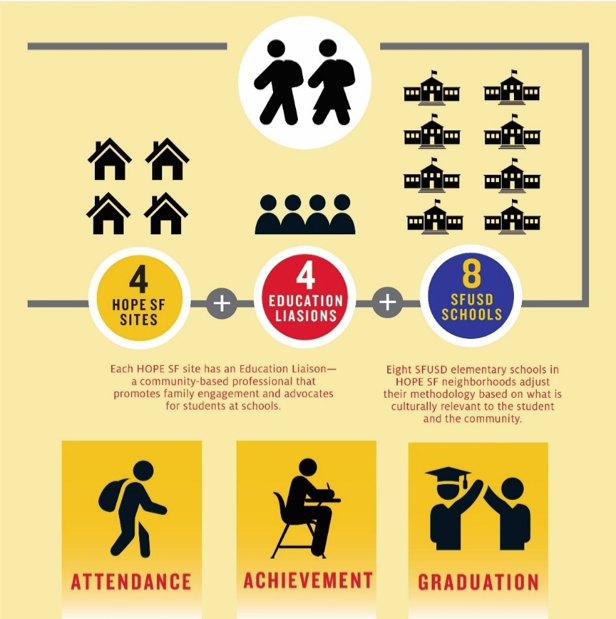In 2012, leaders of HOPE SF examined data across schools, city agencies, and the housing authority in San Francisco. The data match revealed that a whopping 53 percent of students living in public housing complexes were chronically absent. Improving student attendance quickly became a top priority for the initiative education strategy.
Hope SF began by sharing this data with their partners, both residents and agency representatives, and together they developed a set of strategies that has brought the community closer to the schools. The chronic absence rate in the complexes dropped 14 percent — from 53 percent in 2010-11 to 39 percent in 2015 — indicating the initiative’s success.
HOPE SF is a cross-sector initiative dedicated to improving four of San Francisco’s most distressed public housing complexes without large-scale displacement of current residents. Nearly 5,000 individuals live in the four complexes, and the majority are young, poorly educated and unemployed. Situated within the city limits of thriving San Francisco, HOPE SF represents racially segregated communities of concentrated poverty within a city of unprecedented prosperity and innovation.
The Hope SF Elementary Education Strategy
The HOPE SF elementary education strategy includes three core elements focused on bridging schools and families:
Residents who have mastered concepts from Healthy Generation’s trauma-informed trainings lead the Potrero Walking School Bus. Every morning the adults walk with the children to school, but they also share about the student or his community with school staff when they arrive. The ability of these leaders to stay calm, reassuring and maintain safety—whether the challenge is a violent incident occurring as they are walking through the housing complex or a minor dispute between children as they walk to school—is essential to the success of the effort. See the Walking School Bus Slide Show
HOPE SF has also begun to explore the concept of hiring parents, who live in public housing, to serve as peer advocates. These peer advocates receive training with the first goal being to understand their own needs and challenges. Peer advocates also establish their own goals, such as attend parent-teacher conferences or maintain 90 percent attendance for their student, in order to become role models for others.
Who is involved?
Managed by the city of San Francisco, HOPE SF involves a wide array of partners beginning with the residents of HOPE SF, site-based housing developers and community organizations. Other partners include city agencies, such as the San Francisco Unified School District, philanthropy (led by The San Francisco Foundation), and a team of expert researchers and evaluators. Organized as a model for collective impact, HOPE SF focuses on interlocking strategies to address housing, health, community building, education, and economic mobility. Four core values guide Hope SF’s work:
The work is beginning to yield results. Initiative partners note that chronic absence has become an accepted population level indicator across all sectors, not just education. The Education Liaison program is a huge success, as families, schools and the district see it as a useful resource. And the 14 percent decrease in chronic absence rates from 2010-11 to 2015 shows the program is working.
This work continues to unfold and evolve. While the initial progress is promising, many challenges remain, including determining how to best integrate and institutionalize this education strategy—currently supported as a pilot—with other components of this complex initiative to ensure long-term sustainability.
Check out the walking school bus slide show.
You can find out more at the Hope SF website.
